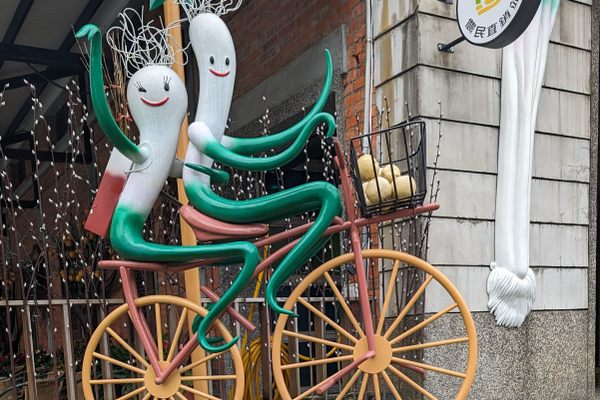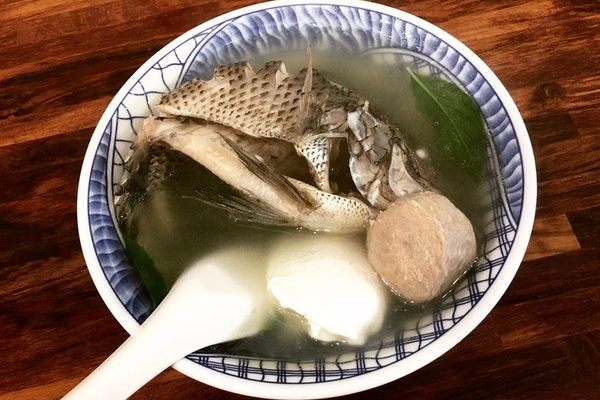In Taiwan, Vegetarian Meat Isn’t Trying to Fool You
Vegan chef George Lee’s new cookbook explores the potential of plant-based foods.
At age 17, chef and video creator George Lee gave up eating meat for 100 days. His A-gong, or grandfather, had passed away, and in Lee’s native Taiwan, traditional Buddhist mourning rituals require the family to abstain from meat after the death of a relative, to accumulate good karma for the deceased.
During that period, Lee and his family ate special funerary meals prepared by the nuns of Dizang Temple in Taipei. Many dishes mimicked classic Taiwanese food by using meat substitutes, in order to ease unaccustomed omnivores into their temporary vegetarianism. The nuns used no onions or garlic, because alliums are believed to impede meditation. “I started to feel something that anchored my interest in vegetarian cooking,” says Lee. Although he returned to eating meat after the period of mourning was over, his outlook on food was forever changed.
Lee attended culinary school in Paris and college in California before returning home to Taiwan during the COVID-19 pandemic. By then, he had become a full-time vegan, and his vegan recipe videos had earned him a social media following and a cookbook deal, although he wasn’t quite sure yet what the focus of his book would be. That changed in 2022, when Lee went back to Dizang Temple as a volunteer. “I think their food really moved me in some way that I had to re-experience,” says Lee. “Still, to this day, it’s some of the best vegetarian cooking that I ever tasted.”

Lee was touched by the thoughtfulness with which the nuns avoided waste, in accordance with the Buddhist ethos of xífú, meaning “to be grateful for one’s blessings.” “They had two blocks of farmland in the back of their central kitchen that was just dedicated to growing their own food,” Lee recalls. “And they also made their own soy products.” As Lee developed his cookbook, his experiences volunteering alongside the nuns, as well as his childhood memories of his family, shaped the story he realized he wanted to tell.
A-Gong’s Table: Vegan Recipes from a Taiwanese Home, published in April 2024, features over 90 vegan Taiwanese recipes drawn from various sources. “Some of them are really just made exactly the way I grew up eating them at home,” Lee says. “And some of them are adapted, like switching a few ingredients.” Other dishes are Lee’s own renditions of non-vegan favorites, collected from food vendors or from the nuns of Dizang Temple. Brimming with memories and stories as well as recipes, the book is a joint project between Lee and his friend, photographer Laurent Hsia, who captured scenes of daily life in Taiwan.
Gastro Obscura spoke with Lee about cookbooks, storytelling, and the appeal of vegetarian meat.
This interview has been edited and condensed for length and clarity.
When did you know that this was the cookbook you wanted to write?
Honestly, I don’t think I knew I was going to write a cookbook until I was doing it. It hasn’t always been my intention to write one, although I’ve always enjoyed reading cookbooks. Originally, [my publisher] wanted me to write about vegan recipes from around the world. I didn’t always specifically focus my videos on Taiwanese cooking, so it’s understandable that they would want me to write a book that was very culturally diverse and captured a bunch of different cuisines.
But I almost immediately rejected that idea, because I couldn’t be a spokesperson for every single cuisine there is. I think it would just be very shallow, and I wouldn’t have any story to tell about the recipes. So I told them that I wanted to focus on Taiwanese cooking.
How do the photos in the book complement the recipes?
When we started working together, Laurent had just started taking photos. We would go on these trips together, just walking around, and over time, Laurent started to go on these walking trips on his own as well, to take pictures of what he noticed. He wanted to capture that feeling of us wandering around Taiwan, so a lot of the photos are taken from a sort of precarious angle, looking downward, like you’re gazing at the ground and seeing the streets when you’re walking.
There are a lot of photos that aren’t dedicated to food. They’re just regular street scenes and such. And this is our experiment, on how we might sort of traverse between the genres of cookbook and photo book. Because there are not many cookbooks that have spreads like these, that are just sequences without any explanation of what the photos are.

What is the attitude towards vegetarian and vegan food in Taiwan?
In Taiwan, veganism is still largely a Western concept. The Mandarin name for “vegan” is just the direct phonetic translation of the English word, while vegetarianism is always connected to Buddhism. You can see that distinction in restaurants. Vegan restaurants in Taiwan will usually cook pretty typical Western-style vegan dishes, like Buffalo cauliflower wings. And if you go to a vegetarian restaurant in Taiwan, it will have the Buddhist swastika on the store sign, and you will not get any alliums in your dishes. Or if you order a vegetarian version of a particular dish at a Taiwanese restaurant, they will cook it the Buddhist way, without alliums, unless you specify.
I had this sort of dilemma when I was writing the introduction, whether to use the word “vegetarian” or “vegan.” It’s hard to wrap your head around these different frames of thinking, but I wanted to write something that treads between those grounds. For example, I’m not used to eating food that’s strictly allium-free, but I make the explicit choice to exclude alliums from a recipe if I think it’s necessary. You do have to think about the flavor or composition, and it’s nice to have it be rooted in something that’s actually a tradition.
Why was it important for you to feature vegetarian meat in your book, instead of focusing only on vegetables?
In Taiwan, there’s three main types of vegetarian meats: [ones] made from gluten, ones made from soy, and also lion’s mane mushrooms. Those are the big groups of vegetarian meat substitutes. I really appreciate the craft that goes into making them rather than buying them. [In the cookbook], I wanted to teach people how to make them from scratch, so you can make them if you can’t find them outside of East Asian countries. And because they just taste better made from scratch, even if you’re in Taiwan.
I noticed that the Buddhist nuns always use those ingredients. And this is a question that I’ve pondered: Why do we need to use these ingredients instead of just eating vegetables? In the book, I write about vegetarian fish made from tofu skin. It is a very traditional dish that comes from prayer culture, where you had to offer the three traditional animal sacrifices: pork, chicken, and fish. Even vegetarian people would have to find substitutes for that.

At first, I really, really wanted to recreate that fish taste, so I threw everything that remotely tasted like seafood into it. And it turned out I was just clouding the flavors; It just tasted like a mass of seaweed and stuff. Then one day I went to the traditional market, and I asked a vendor that I knew about the vegetarian fish. And she just told me, “Well, actually, this dish was never supposed to taste like fish.”
Now I think what’s special about these ingredients is that they’re not really trying to be meat. If you taste the gluten products like gluten rolls and gluten “intestine”—which is the direct translation—they don’t really taste like any meat, but they’re sort of chewy and bouncy. They’re all just different ways of achieving textures that vegetables don’t have. With good vegetarian cooking, I think you still need something to chew on. I’m happy to eat just vegetables with rice. It’s nice sometimes. But to add variety, it makes food more interesting to have those extra little things.

Three-Cup Lion’s Mane Mushrooms
From "A-Gong's Table: Vegan Recipes from a Taiwanese Home" by George Lee
- Prep time: 20 minutes
- Cook time: 25 minutes
- Total time: 45 minutes
- Serves 4 as part of a spread
Ingredients
- 2 tablespoons toasted sesame oil, preferably toasted black sesame oil
- 2 (1 ½ inch) pieces unpeeled ginger, thinly sliced
- 10 ½ ounces lion’s mane mushrooms
- 1 tablespoon golden granulated sugar
- 2 tablespoons light soy sauce
- 2 tablespoons Taiwanese rice cooking wine
- 1 cup water
- 1 fresh red chili, sliced on a bias
- 1 bunch Taiwanese or Thai basil
Instructions
-
Heat a wok over medium-high heat until just smoking. Turn off the heat, ladle in the toasted sesame oil and swirl it around to create a nonstick surface.
-
Turn down the heat to medium. (Be conservative with the heat. Toasted sesame oil tends to taste bitter when overheated).
-
Add the ginger and slowly sizzle for seven to 10 minutes, until they are blistered, dry-looking, and curled.
-
Add the lion’s mane mushrooms and toss a few times to coat them in the sesame oil and ginger.
-
Add the sugar, swirl in the light soy sauce and rice cooking wine, and stir-fry for a few seconds to glaze all the pieces.
-
Add the water and bring to a boil.
-
Lower the heat so the sauce is still bubbling but not as rapidly and cook for about 15 minutes to allow the mushrooms to soak up all the flavors and the sauce to reduce by about three-quarters.
-
Remove from the heat and add the sliced chilies and basil leaves, tossing to combine.
-
Transfer to a serving dish and serve immediately.
- Cool any leftovers and store in an airtight container in the refrigerator for up to 3 days.
Notes and Tips
“Sānbēi (three cups) refers to the essential condiments used in this dish: toasted sesame oil, soy sauce, and rice cooking wine,” Lee writes. “This is a sauce that can go with just about anything.” The best-known version of this dish uses chicken as the main ingredient, but Lee suggests several plant-based alternatives, including mushrooms, tofu, lima beans, or gluten.
Gastro Obscura covers the world’s most wondrous food and drink.
Sign up for our regular newsletter.




























Follow us on Twitter to get the latest on the world's hidden wonders.
Like us on Facebook to get the latest on the world's hidden wonders.
Follow us on Twitter Like us on Facebook